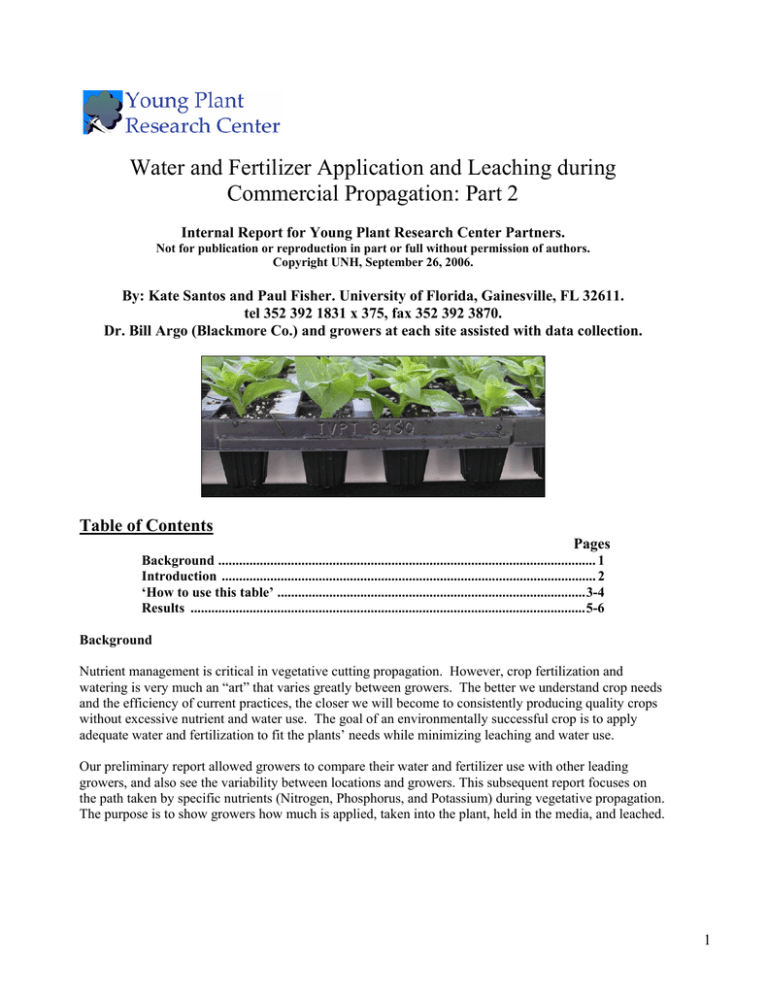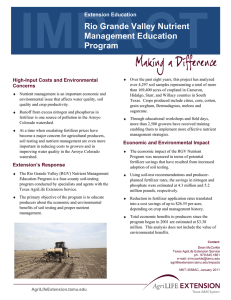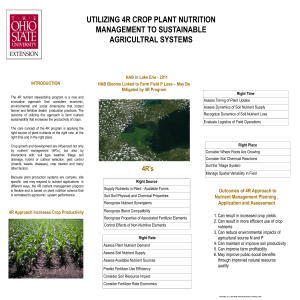Water and Fertilizer Application and Leaching during Commercial Propagation: Part 2
advertisement

Water and Fertilizer Application and Leaching during Commercial Propagation: Part 2 Internal Report for Young Plant Research Center Partners. Not for publication or reproduction in part or full without permission of authors. Copyright UNH, September 26, 2006. By: Kate Santos and Paul Fisher. University of Florida, Gainesville, FL 32611. tel 352 392 1831 x 375, fax 352 392 3870. Dr. Bill Argo (Blackmore Co.) and growers at each site assisted with data collection. Table of Contents Pages Background ............................................................................................................. 1 Introduction ............................................................................................................ 2 ‘How to use this table’ .........................................................................................3-4 Results ..................................................................................................................5-6 Background Nutrient management is critical in vegetative cutting propagation. However, crop fertilization and watering is very much an “art” that varies greatly between growers. The better we understand crop needs and the efficiency of current practices, the closer we will become to consistently producing quality crops without excessive nutrient and water use. The goal of an environmentally successful crop is to apply adequate water and fertilization to fit the plants’ needs while minimizing leaching and water use. Our preliminary report allowed growers to compare their water and fertilizer use with other leading growers, and also see the variability between locations and growers. This subsequent report focuses on the path taken by specific nutrients (Nitrogen, Phosphorus, and Potassium) during vegetative propagation. The purpose is to show growers how much is applied, taken into the plant, held in the media, and leached. 1 Introduction An unrooted cutting passes through five developmental stages, according to Mark Wilson and his article in the Ball Red Book on “Rooting Cuttings.” Stage 0: Arrival Stage 1: Sticking Stage 2: Callusing Stage 3: Root Development Stage 4: Toning the rooted cutting. Stage 0 lays the groundwork for the subsequent four stages in unrooted cutting propagation. The nutrient content in the stock plant at the time cuttings are taken is what sustains the cutting until root emergence enables the plant to actively take-up nutrients. One goal of this project is to track the progression of the nutrients in the plant tissues of petunia and calibrachoa cuttings through the 5 stages of vegetative propagation. In this research project the five stages will be referenced by the approximate age of the cuttings at the time the samples were taken. Therefore the stages will be referred to as follows: Stage 0: Cuttings before sticking (Day 0) Stage 1: Cuttings have been stuck for 1 week Stage 2: Cuttings have been stuck for 2 weeks Stage 3: Cuttings have been stuck for 3 weeks Stage 4: Cuttings have been stuck for 4 weeks Additional data that were collected during this trial to further track nutrients during the course of propagation included: water collectors to measure the sum of nutrients applied through water soluble fertilizer applications (boom watering, hand watering, or mist); media squeeze tests to measure the nutrient content in the media over time; and, leachate collectors to measure the amount of nutrients leached over time. The data for this research was collected through the collaborative efforts of eight greenhouse facilities: Center Greenhouses (Colorado), D.S. Cole Growers (New Hampshire), Four-Star Greenhouses (Michigan), Glass Corner Greenhouses (Michigan), Kube-Pak Corporation (New Jersey), Lucas Greenhouses (New Jersey), Pleasant View Gardens (New Hampshire) and Welby Gardens (Colorado). Sampling Protocol 1. The Day 0 media values were calculated by subirrigating 105 count liner trays filled with media samples from each site, in deionized water until saturated. The trays were then removed from the water and allowed to sit for 24 hours before a media squeeze test was done. The solutions were sent to Quality Analytical Laboratories for analysis. 2. Tissue and solution samples were taken on Day 7 at each of the 8 grower locations. 3. The plugs were washed in four baths of deionized water to remove all traces of media particles and fertilizer residue from the leaves and roots. The cuttings were patted dry, weighed, placed in paper bags and put in a drying oven for 48 hours or until all moisture was removed from tissue. 4. The dried tissue samples were weighed again and sent to Quality Analytical Laboratories for a standard tissue nutrient analysis. 5. The leachate, media squeeze, and overhead irrigation solutions were sent to Quality Analytical Laboratories for standard nutrient analysis including nitrogen. 2 How to Use Tables The goal of these tables is to illustrate how dynamic the needs of a cutting crop can be from one week to the next; while also showing how crop management techniques (fertilizer and water usage) affect each component (tissue, media, and leachate). The tables can also offer you an insight into your particular crop to serve as a tool you can use when making future nutrient management decisions. Table 1 tracks Nitrogen, Phosphorus and Potassium (NPK) concentration in two main sites during a 4week propagation cycle for petunia and calibrachoa cuttings. These sites are in the applied fertilizer solution and in the leachate. Table 2 supplements Table 1, by tracking Nitrogen, Phosphorus and Potassium (NPK) percentage in the tissue and concentration in the media. The eight participating greenhouse locations are assigned a letter that corresponds with their personal results. These letters are listed in the first column, titled “Grower.” The second column separates each crop by age group, age 0 represents the stage of the cutting prior to sticking. Each subsequent age group represents stages 1, 2, 3 and 4 (as defined on page 2). 1. Applied Fertilizer Solution The applied fertilizer solution represents nutrients supplementally added to the crop, through hand, mist, or boom watering. The ‘Reported’ column is the fertilizer type and concentration each grower chose to apply at a given crop stage, it is important to note that not all grower sites applied fertilizer at every stage, these exceptions are designated by ‘Clear Water’. The ‘Measured’ columns are the specific data measurements for each site. The first sub-column is the number of liters of fertilizer solution applied per tray per week. The subsequent 3 columns are the % NPK applied at each stage. This section enables participants to compare their water usage against other leading greenhouses in the country, it also provides them with information on the amount of nutrients they apply during a given crop cycle as compared to others. 2. Tissue The tissue columns track the NPK content within the cuttings, including the root mass. The information presented here enables you to identify possible nutrient deficiencies within your cuttings. For example, if your Stage 0 values appear to be markedly lower than the average or much lower than the subsequent stages of your own crop there is a possibility your cuttings are arriving with low nutrient stores. To further confirm low nutrient content compare these values against the averages calculated in the “Nutrient Survey Report” supplement. The NPK values also serve as references to compare against future Tissue Sample results received. 3 How to Use Tables Continued… 3. Media The media columns track the ppm of NPK contained within the media. If there are a lot of fluctuations (low to high or vice versa) in these numbers from week to week it may mean that you are leaching a lot of nutrients. These columns are helpful to compare with your water usage and leachate values to determine excessive water or nutrient applications. 4. Leachate The first sub-column describes how much solution (in liters) is leached from a propagation tray per week. The lower these numbers are, the less fertilizer you need to re-apply to replenish the nutrients leached from the media and the less run-off you are contributing to the environment. Leaching is more likely (but not exclusively) to occur at the beginning of the crop cycle because the cutting does not have roots yet for uptake, and therefore most of the solution is leached. The subsequent 3 columns show the amount of NPK leached per crop stage. Fertilizer and water management decisions can be made by identifying what stages the most nutrients are being leached from the media and adjusting one or both of those factors accordingly. 4 Table 1: Nutrient balance in propagation of calibrachoa (growers B, C, D, G, H), diascia (F), or petunia (A, E). The table shows the volume and nutrient concentration (ppm) in fertilizer solution applied per week for 8 growers (coded A to H). The nutrient concentration in the leachate is also reported. Ap p lie d F e rtilize r S o lu tio n 1 R eported Com pa ny W eek A A A A B B B B C C C C D D D D E E E E F F F F G G G G H H H H A verag e A verag e A verag e A verag e 1 2 3 4 1 2 3 4 1 2 3 4 1 2 3 4 1 2 3 4 1 2 3 4 1 2 3 4 1 2 3 4 1 2 3 4 L e a c h a te M e asure d M e asure d L ite rs / L ite rs / # D a ys # D a ys # D a ys F e rt. ppm N ppm P ppm K ppm N ppm P ppm K T ra y Spot C le a r F e rt. [ p p m N ] T ra y 0 1 1 0 0 0 0 0 0 0 0 0 0 3 4 4 0 0 0 0 1 0 0 0 0 0 0 0 0 1 2 2 0 0 0 6 7 5 0 0 3 0 0 5 7 2 0 0 5 7 5 4 5 2 1 6 7 7 4 0 0 2 0 0 4 3 4 1 0 1 2 3 2 2 2 1 0 1 2 2 0 0 2 3 0 3 3 1 0 0 3 4 7 2 4 4 2 00 2 00 2 00 2 00 0 2 00 1 70 2 00 2 00 2 00 1 50 1 50 0 3 00 3 00 3 00 0 0 1 50 1 50 0 0 1x150;2x300 1x150;2x300 0 0 2 00 2 00 1 00 1 00 1 00 1 00 1.6 2.0 1.1 2.3 2.9 0.4 0.8 1.6 1.7 1.3 3.4 3.4 1.4 1.2 3.8 3.6 0.9 0.6 0.9 2.3 1.0 0.7 3.1 1.9 1.2 0.5 0.4 1.1 1.4 3.6 0.6 0.6 1.5 1.3 1.8 2.1 80 146 139 110 6 82 130 113 68 100 82 64 1 195 148 158 0 2 94 106 5 0 52 73 7 12 19 107 23 142 79 78 24 85 93 101 4 11 11 8 0 5 11 10 8 12 10 7 4 10 11 12 0 1 20 17 1 1 12 12 0 1 2 17 3 18 8 8 3 7 11 11 65 133 128 94 5 92 130 112 65 93 76 58 8 228 175 185 5 9 80 100 10 6 65 88 7 12 24 135 32 113 89 88 25 86 96 108 0.9 0.3 0.3 0.9 8.1 3.0 0.8 2.4 2.5 0.3 2.1 1.0 0.9 0.0 0.0 0.5 0.3 1.7 0.2 0.9 1.0 0.0 2.8 1.4 3.3 0.9 0.1 0.3 0.6 3.5 1.0 1.8 2.2 1.2 0.9 1.2 1 88 2 08 12 16 6 37 47 1 21 48 39 28 1 83 2 38 68 46 1 71 1 70 15 37 28 2 87 1 02 84 1 08 53 13 29 1 21 3 27 83 48 54 1 65 71 41 1 00 92 91 2 2 1 4 4 5 52 26 7 34 48 22 12 6 75 16 11 7 46 19 12 7 32 4 4 15 81 16 10 11 53 25 8 11 278 230 9 14 9 34 32 101 170 74 19 133 522 131 64 234 202 102 57 30 310 183 62 58 103 24 45 146 880 79 80 59 309 107 46 97 Use this table to evaluate your individual water/fertilizer programs. Look at the amount (L) you are applying each week and how much is being leached out, if you are leaching 50% or more of what you are applying, try reducing the volume you apply at each irrigation. Look at the ppm applied compared to the ppm leached for each nutrient. Early in the crop if the applied ppm levels are low, but the leachate levels are high, this may signify the loss of the pre-plant charge in your media. Upon root emergence, the cutting should be taking up most of the nutrients, therefore, the later stages may still have high ppm in the applied, but they should have low ppm in the leachate. If you have high nutrient levels in your leachate during stages 3 and stage 4, you are probably applying more fertilizer than the plants require. Measured ppm levels may be lower than reported ppm levels due to the ratio of clear irrigations to fertilizations. For example if the liners were fertigated early in a stage but then subsequently irrigated with clear water, the measured levels would be lower than the reported ppm applied due to dilution. 5 Table 2: Nutrient balance in propagation of calibrachoa (growers B, C, D, G, H), diascia (F), or petunia (A, E). The percent Nitrogen (N), Phosphorus (P) and Potassium (K) in the tissue and media (squeeze test) are also reported. 2 Tissue Media Measured Measured Grower Week %N %P %K ppm N ppm P ppm K A A A A A B B B B B C C C C C D D D D D E E E E E F F F F F G G G G G H H H H H Average Average Average Average Average 0 1 2 3 4 0 1 2 3 4 0 1 2 3 4 0 1 2 3 4 0 1 2 3 4 0 1 2 3 4 0 1 2 3 4 0 1 2 3 4 0 1 2 3 4 6.1 4.6 4.3 4.2 4.4 3.9 3.8 4.3 3.6 3.8 4.8 2.9 3.2 2.5 3.6 4.0 3.3 3.8 4.3 3.8 4.2 2.7 2.0 3.2 2.9 3.0 1.8 1.2 M 3.6 5.4 3.0 3.0 3.1 2.3 4.6 2.7 2.3 3.0 3.2 4.5 3.1 3.0 3.4 3.4 0.7 0.5 0.7 0.7 0.5 0.6 0.5 0.5 0.4 0.4 0.6 0.4 0.4 0.4 0.5 0.5 0.4 0.5 0.7 0.6 0.5 0.3 0.4 0.6 0.6 0.4 0.3 0.3 M 0.5 0.5 0.3 0.3 0.6 0.4 0.7 0.4 0.4 0.4 0.5 0.5 0.4 0.4 0.5 0.5 5.7 4.4 5.2 4.7 4.5 3.6 3.9 3.9 3.3 3.5 4.3 2.5 2.9 2.3 3.3 4.0 3.2 4.3 5.4 4.7 5.0 3.3 2.8 3.9 4.1 3.4 1.7 2.3 M 3.7 4.6 3.0 2.9 3.6 2.5 3.6 2.2 2.3 3.3 2.6 4.3 3.0 3.3 3.8 3.6 39 161 150 4 26 58 8 56 22 103 21 49 16 19 142 24 133 57 52 159 63 268 7 31 11 135 140 63 82 131 M 34 4 52 85 48 127 76 36 32 55 115 54 37 86 20 71 65 1 1 21 1 6 1 3 9 46 14 3 25 6 42 9 2 3 17 126 13 11 8 11 26 14 16 10 M 17 1 5 9 14 32 19 10 12 14 45 18 6 9 71 209 122 31 34 96 7 46 16 82 52 155 37 29 152 66 259 119 82 245 76 303 68 53 33 96 181 109 64 76 M 65 15 47 103 89 268 90 51 58 78 181 76 47 98 This table can be used in conjunction with Table 1. The tissue percentages enable you to see during what growth stages your cuttings appear to be the most nutrient deficient, or when they may have exceedingly high nutrient levels. It is helpful to not only compare the values throughout your own crop, but to look at other growers and the overall averages to see how you compare. The media nutrient levels serve as indicators as well. If you have low levels by stage 1, it could mean you have already leached your pre-plant charge out – before the cutting has even rooted! Lower levels later on, can signify plant uptake, and may provide insight on the best points during the crop to fertilize. 6





